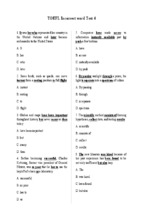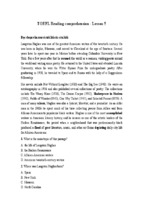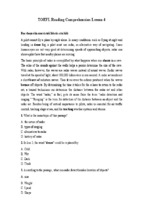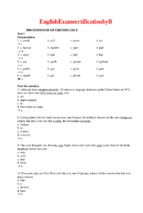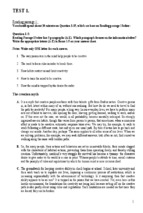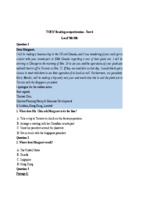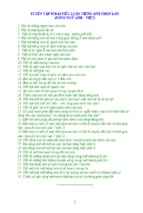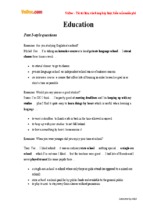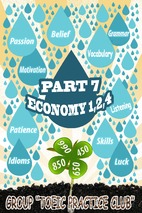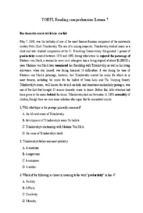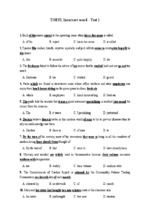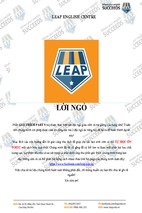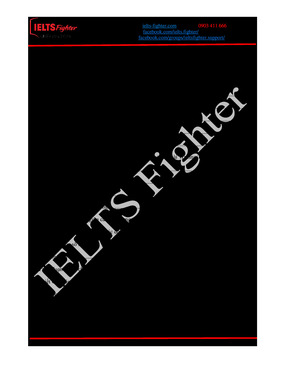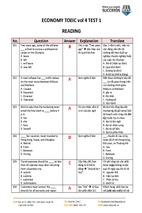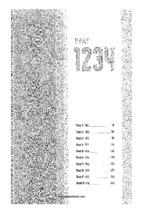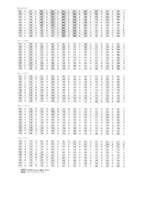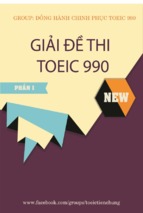General Training Reading sample task – Flow-chart completion
ROBOTS AT WORK
A
The newspaper production process has come a long
way from the old days when the paper was written,
edited, typeset and ultimately printed in one building
with the journalists working on the upper floors and
the printing presses going on the ground floor. These
days the editor, subeditors and journalists who put the
paper together are likely to find themselves in a
totally different building or maybe even in a different
city. This is the situation which now prevails in
Sydney. The daily paper is compiled at the editorial
headquarters, known as the prepress centre, in the
heart of the city, but printed far away in the suburbs at
the printing centre. Here human beings are in the
minority as much of the work is done by automated
machines controlled by computers.
day’s paper and the publishing order are determined
at head office, the information is punched into the
computer and the LGVs are programmed to go about
their work. The LGVs collect the appropriate size
paper reels and take them where they have to go.
When the press needs another reel its computer alerts
the LGV system. The Sydney LGVs move busily
around the press room fulfilling their two key
functions to collect reels of newsprint either from the
reel stripping stations, or from the racked supplies in
the newsprint storage area. At the stripping station
the tough wrapping that helps to protect a reel of
paper from rough handling is removed. Any
damaged paper is peeled off and the reel is then
weighed.
E
B
Once the finished newspaper has been created for the
next morning’s edition, all the pages are transmitted
electronically from the prepress centre to the printing
centre. The system of transmission is an update on the
sophisticated page facsimile system already in use on
many other newspapers. An imagesetter at the
printing centre delivers the pages as film. Each page
takes less than a minute to produce, although for
colour pages four versions, once each for black, cyan,
magenta and yellow are sent. The pages are then
processed into photographic negatives and the film is
used to produce aluminium printing plates ready for
the presses.
Then one of the four paster robots moves in.
Specifically designed for the job, it trims the paper
neatly and prepares the reel for the press. If required
the reel can be loaded directly onto the press; if not
needed immediately, an LGV takes it to the storage
area. When the press computer calls for a reel, an
LGV takes it to the reel loading area of the presses. It
lifts the reel into the loading position and places it in
the correct spot with complete accuracy. As each reel
is used up, the press drops the heavy cardboard core
into a waste bin. When the bin is full, another LGV
collects it and deposits the cores into a shredder for
recycling.
F
C
A procession of automated vehicles is busy at the new
printing centre where the Sydney Morning Herald is
printed each day. With lights flashing and warning
horns honking, the robots (to give them their correct
name, the LGVs or laser guided vehicles) look for all
the world like enthusiastic machines from a science
fiction movie, as they follow their own random paths
around the plant busily getting on with their jobs.
Automation of this kind is now standard in all modern
newspaper plants. The robots can detect unauthorised
personnel and alert security staff immediately if they
find an “intruder”; not surprisingly, tall tales are
already being told about the machines starting to take
on personalities of their own.
The LGVs move at walking speed. Should anyone
step in front of one or get too close, sensors stop the
vehicle until the path is clear. The company has
chosen a laserguide function system for the vehicles
because, as the project development manager says
“The beauty of it is that if you want to change the
routes, you can work out a new route on your
computer and lay it down for them to follow”. When
an LGV’s batteries run low, it will take itself off line
and go to the nearest battery maintenance point for
replacement batteries. And all this is achieved with
absolute minimum human input and a much reduced
risk of injury to people working in the printing
centres.
G
D
The robots’ principal job, however, is to shift the
newsprint (the printing paper) that arrives at the plant
in huge reels and emerges at the other end
some time later as newspapers. Once the size of the
The question newspaper workers must now ask,
however is, “how long will it be before the robots are
writing the newspapers as well as running the
printing centre, churning out the latest edition every
morning?”
General Training Reading sample task – Flow-chart completion
Questions 33 – 40
Complete the flow-chart below.
Choose NO MORE THAN THREE WORDS from the text for each answer.
Write your answers in boxes 33-40 on your answer sheet.
The Production Process
The newspaper is compiled at the editorial headquarters by the
journalists.
Æ
The final version of the text is 33 ............... to the printing centre.
Æ
The pages arrive by facsimile.
Æ
The pages are converted into 34 …………… .
Æ
35 …………… are made for use in the printing presses.
The LGVs are 36 …………… by computer.
Æ
The LGVs collect the reels of paper.
Æ
The LGVs remove the 37 …………… from the reel.
Æ
The reel is 38 …………… .
Æ
The reel is trimmed and prepared by the 39 …………… .
Æ
The reel is taken to the press.
The reel is taken to the
40 …………… .
General Training Reading sample task – Flow-chart completion
Answers
33
transmitted (electronically)
34
(photographic) film/negative(s)
35
(aluminium) printing plates
36
programmed
37
damaged paper/wrapping
38
weighed
39
paster robot(s)
40
storage area
Words in brackets are optional - they are correct, but not necessary. Alternative answers are
separated by a slash (/).
General Training Reading sample task – Identifying information
Read the text below and answer Questions 1-8.
London to Brighton Bike Ride
The start
The bike ride starts at Clapham Common tube station.
• Your Start Time is indicated by the colour of your body number in this
pack. It is also printed on the address label of the envelope. Please arrive
no earlier than 30 minutes before that time.
• We allocate an equal number of cyclists for each Start Time to ensure a
steady flow. Please keep to the time you've been given so we can keep to
our schedule and avoid delaying other riders and prevent 'bunching'
further down the route.
• An Information Point, toilets and refreshment stands will be open from
very early in the day.
Ride carefully
We put together as many facilities as possible to help ensure you have a
troublefree day. But we also rely on you to ride safely and with due
consideration for other cyclists and road users. Although many roads are
closed to oncoming traffic, this is not always the case and you should be aware
of the possibility that there could be vehicles coming in the opposite direction.
Please do not attempt reckless overtaking whilst riding – remember it is NOT a
race.
Follow all instructions
Every effort is made to ensure that the route is well signed and marshalled.
Please obey all directions from police and marshals on the route. If you hear a
motorcycle marshal blow his/her whistle three times, move left.
Wear a helmet
Every year we are delighted to see more riders wearing protective helmets, but
we would like to see every cyclist on the ride wearing one. More than half of
reported injuries in cycling accidents are to the head, and a helmet gives the
best protection when the head hits the ground.
Attracting assistance
If you have an accident, ask a marshal for help; they are in contact with the
support/emergency services. To call for help from our motorcycle marshals,
give a 'thumbs down' signal. The marshal will do all he/she can to help,
providing he/she is not already going to a more serious accident. If a
motorcycle marshal slows down to help you, but you have just stopped for a
rest and don't need help, please give a 'thumbs up' signal and he/she will carry
on. Remember – thumbs down means 'I need help'.
General Training Reading sample task – Identifying information
In case of breakdown
Refer to your route map and make your way to a Mechanics Point. Mechanical
assistance is free when you show your Rider Identity Card; you just pay for the
parts.
Refreshment stops
Look out for these along the route. Most are organised by voluntary clubs and
their prices give you real value for money. They are also raising money for their
local communities and the British Heart Foundation, so please give them your
support.
Rain or shine – be prepared
In the event of very bad weather, watch out for signs to wet weather stations en
route. Good waterproofs, like a cycle cape, are essential. Our first aid staff can
only supply bin liners and by the time you get one you may be very wet.
However, the English summer is unpredictable – it may also be hot, so don't
forget the sun protection cream as well!
If you have to drop out
We will try to pick up your bike for you on the day. Call Bike Events (01225
310859) no more than two weeks after the ride to arrange collection. Sorry, we
cannot guarantee this service nor can we accept liability for any loss or damage
to your bike. Bike Events will hold your bike for three months, after which it
may be disposed of. You will be charged for all costs incurred in returning your
cycle.
General Training Reading sample task – Identifying information
Questions 1 – 8
Do the following statements agree with the information given in the text?
In boxes 1-8 on your answer sheet, write
TRUE
FALSE
NOT GIVEN
if the statement agrees with the information
if the statement contradicts the information
if there is no information on this
1
You should not arrive more than half an hour before your allocated starting time.
2
Your Rider Identity Card will be sent to you before the event.
3
Some roads may have normal traffic flow on them.
4
Helmets are compulsory for all participants.
5
Refreshments are free to all participants during the ride.
6
If you need a rest you must get off the road.
7
First aid staff can provide cycle capes.
8
Bike Events will charge you for the return of your bike.
General Training Reading sample task – Identifying information
Answers
1
TRUE
2
NOT GIVEN
3
TRUE
4
FALSE
5
FALSE
6
NOT GIVEN
7
FALSE
8
TRUE
General Training Reading sample task – Matching features
[Note: This is an extract from a General Training Reading text on the subject
of the history of cinema. The text preceding this extract gave a general overview.]
Although French, German, American and British pioneers have all been credited with the
invention of cinema, the British and the Germans played a relatively small role in its
worldwide exploitation. It was above all the French, followed closely by the Americans,
who were the most passionate exporters of the new invention, helping to start cinema in
China, Japan, Latin America and Russia. In terms of artistic development it was again
the French and the Americans who took the lead, though in the years before the First
World War, Italy, Denmark and Russia also played a part.
In the end it was the United States that was to become, and remain, the largest single
market for films. By protecting their own market and pursuing a vigorous export policy,
the Americans achieved a dominant position on the world market by the start of the First
World War. The centre of filmmaking had moved westwards, to Hollywood, and it was
films from these new Hollywood studios that flooded onto the world’s film markets in the
years after the First World War, and have done so ever since. Faced with total
Hollywood domination, few film industries proved competitive. The Italian industry,
which had pioneered the feature film with spectacular films like “Quo Vadis?” (1913) and
“Cabiria” (1914), almost collapsed. In Scandinavia, the Swedish cinema had a brief
period of glory, notably with powerful epic films and comedies. Even the French cinema
found itself in a difficult position. In Europe, only Germany proved industrially capable,
while in the new Soviet Union and in Japan, the development of the cinema took place in
conditions of commercial isolation.
Hollywood took the lead artistically as well as industrially. Hollywood films appealed
because they had better constructed narratives, their special effects were more
impressive, and the star system added a new dimension to screen acting. If Hollywood
did not have enough of its own resources, it had a great deal of money to buy up artists
and technical innovations from Europe to ensure its continued dominance over present or
future competition.
From early cinema, it was only American slapstick comedy that successfully developed
in both short and feature format. However, during this ‘Silent Film’ era, animation,
comedy, serials and dramatic features continued to thrive, along with factual films or
documentaries, which acquired an increasing distinctiveness as the period progressed. It
was also at this time that the avant-garde film first achieved commercial success, this
time thanks almost exclusively to the French and the occasional German film.
Of the countries which developed and maintained distinctive national cinemas in the
silent period, the most important were France, Germany and the Soviet Union. Of these,
the French displayed the most continuity, in spite of the war and post-war economic
uncertainties. The German cinema, relatively insignificant in the pre-war years, exploded
on to the world scene after 1919. Yet even they were both overshadowed by the Soviets
after the 1917 Revolution. They turned their back on the past, leaving the style of the
pre-war Russian cinema to the émigrés who fled westwards to escape the Revolution.
General Training Reading sample task – Matching features
The other countries whose cinemas changed dramatically are: Britain, which had an
interesting but undistinguished history in the silent period; Italy, which had a brief
moment of international fame just before the war; the Scandinavian countries,
particularly Denmark, which played a role in the development of silent cinema quite out
of proportion to their small population; and Japan, where a cinema developed based
primarily on traditional theatrical and, to a lesser extent, other art forms and only
gradually adapted to western influence.
General Training Reading sample task – Matching features
Questions 34 – 40
Look at the following statements (Questions 34-40) and the list of countries below.
Match each statement with the correct country, A-J.
Write the correct letter, A-J, in boxes 34-40 on your answer sheet.
NB You may use any letter more than once.
34
It helped other countries develop their own film industry.
35
It was the biggest producer of films.
36
It was first to develop the 'feature' film.
37
It was responsible for creating stars.
38
It made the most money from 'avantgarde' films.
39
It made movies based more on its own culture than outside influences.
40
It had a great influence on silent movies, despite its size.
List of Countries
A
B
C
D
E
F
G
H
I
J
France
Germany
USA
Denmark
Sweden
Japan
Russia
Italy
Britain
China
General Training Reading sample task – Matching features
Answers
34
A
35
C
36
H
37
C
38
A
39
F
40
D
General Training Reading sample task – Matching headings
Questions 27 – 32
The text has seven paragraphs, A-G.
Choose the correct heading for paragraphs A, B and D-G from the list of headings
below.
Write the correct number, i-ix,in boxes 27-32 on your answer sheet.
List of Headings
i
ii
iii
iv
v
vi
vii
viii
ix
27
Paragraph A
28
Paragraph B
Robots working together
Preparing LGVs for takeover
Looking ahead
The LGVs’ main functions
Split location for newspaper production
Newspapers superseded by technology
Getting the newspaper to the printing centre
Controlling the robots
Beware of robots!
Example
Paragraph C
29
Paragraph D
30
Paragraph E
31
Paragraph F
32
Paragraph G
ix
General Training Reading sample task – Matching headings
ROBOTS AT WORK
A
The newspaper production process has come a long
way from the old days when the paper was written,
edited, typeset and ultimately printed in one building
with the journalists working on the upper floors and
the printing presses going on the ground floor. These
days the editor, subeditors and journalists who put the
paper together are likely to find themselves in a
totally different building or maybe even in a different
city. This is the situation which now prevails in
Sydney. The daily paper is compiled at the editorial
headquarters, known as the prepress centre, in the
heart of the city, but printed far away in the suburbs at
the printing centre. Here human beings are in the
minority as much of the work is done by automated
machines controlled by computers.
day’s paper and the publishing order are determined
at head office, the information is punched into the
computer and the LGVs are programmed to go about
their work. The LGVs collect the appropriate size
paper reels and take them where they have to go.
When the press needs another reel its computer alerts
the LGV system. The Sydney LGVs move busily
around the press room fulfilling their two key
functions to collect reels of newsprint either from the
reel stripping stations, or from the racked supplies in
the newsprint storage area. At the stripping station
the tough wrapping that helps to protect a reel of
paper from rough handling is removed. Any
damaged paper is peeled off and the reel is then
weighed.
E
B
Once the finished newspaper has been created for the
next morning’s edition, all the pages are transmitted
electronically from the prepress centre to the printing
centre. The system of transmission is an update on the
sophisticated page facsimile system already in use on
many other newspapers. An imagesetter at the
printing centre delivers the pages as film. Each page
takes less than a minute to produce, although for
colour pages four versions, once each for black, cyan,
magenta and yellow are sent. The pages are then
processed into photographic negatives and the film is
used to produce aluminium printing plates ready for
the presses.
Then one of the four paster robots moves in.
Specifically designed for the job, it trims the paper
neatly and prepares the reel for the press. If required
the reel can be loaded directly onto the press; if not
needed immediately, an LGV takes it to the storage
area. When the press computer calls for a reel, an
LGV takes it to the reel loading area of the presses. It
lifts the reel into the loading position and places it in
the correct spot with complete accuracy. As each reel
is used up, the press drops the heavy cardboard core
into a waste bin. When the bin is full, another LGV
collects it and deposits the cores into a shredder for
recycling.
F
C
A procession of automated vehicles is busy at the new
printing centre where the Sydney Morning Herald is
printed each day. With lights flashing and warning
horns honking, the robots (to give them their correct
name, the LGVs or laser guided vehicles) look for all
the world like enthusiastic machines from a science
fiction movie, as they follow their own random paths
around the plant busily getting on with their jobs.
Automation of this kind is now standard in all modern
newspaper plants. The robots can detect unauthorised
personnel and alert security staff immediately if they
find an “intruder”; not surprisingly, tall tales are
already being told about the machines starting to take
on personalities of their own.
The LGVs move at walking speed. Should anyone
step in front of one or get too close, sensors stop the
vehicle until the path is clear. The company has
chosen a laserguide function system for the vehicles
because, as the project development manager says
“The beauty of it is that if you want to change the
routes, you can work out a new route on your
computer and lay it down for them to follow”. When
an LGV’s batteries run low, it will take itself off line
and go to the nearest battery maintenance point for
replacement batteries. And all this is achieved with
absolute minimum human input and a much reduced
risk of injury to people working in the printing
centres.
G
D
The robots’ principal job, however, is to shift the
newsprint (the printing paper) that arrives at the plant
in huge reels and emerges at the other end
some time later as newspapers. Once the size of the
The question newspaper workers must now ask,
however is, “how long will it be before the robots are
writing the newspapers as well as running the
printing centre, churning out the latest edition every
morning?”
General Training Reading sample task – Matching headings
Answers
27
v
28
vii
29
iv
30
i
31
viii
32
iii
General Training Reading sample task – Multiple choice
[Note: This is an extract from a General Training Reading text on the subject of
coal. The text preceding this extract catalogued the general belief that extracting
and using coal is bad for the environment.]
Greenhouse gases arise from a wide range of sources and their increasing
concentration is largely related to the compound effects of increased population,
improved living standards and changes in lifestyle. From a current base of 5
billion, the United Nations predicts that the global population may stabilise in the
twenty-first century between 8 and 14 billion, with more than 90 per cent of the
projected increase taking place in the world’s developing nations. The associated
activities to support that growth, particularly to produce the required energy and
food, will cause further increases in greenhouse gas emissions. The challenge,
therefore, is to attain a sustainable balance between population, economic
growth and the environment.
The major greenhouse gas emissions from human activities are carbon dioxide
(CO2), methane and nitrous oxide. Chlorofluorocarbons (CFCs) are the only
major contributor to the greenhouse effect that does not occur naturally, coming
from such sources as refrigeration, plastics and manufacture. Coal’s total
contribution to greenhouse gas emissions is thought to be about 18 per cent, with
about half of this coming from electricity generation.
The worldwide coal industry allocates extensive resources to researching and
developing new technologies and ways of capturing greenhouse gases.
Efficiencies are likely to be improved dramatically, and hence CO2 emissions
reduced, through combustion and gasification techniques which are now at pilot
and demonstration stages.
Clean coal is another avenue for improving fuel conversion efficiency.
Investigations are under way into super-clean coal (35 per cent ash) and
ultraclean coal (less than 1 per cent ash). Super-clean coal has the potential to
enhance the combustion efficiency of conventional pulverised fuel power plants.
Ultraclean coal will enable coal to be used in advanced power systems such as
coal-fired gas turbines which, when operated in combined cycle, have the
potential to achieve much greater efficiencies.
Defendants of mining point out that, environmentally, coal mining has two
important factors in its favour. It makes only temporary use of the land and
produces no toxic chemical wastes. By carefully preplanning projects,
implementing pollution control measures, monitoring the effects of mining and
rehabilitating mined areas, the coal industry minimises the impact on the
neighbouring community, the immediate environment and long-term land
capability.
General Training Reading sample task – Multiple choice
Dust levels are controlled by spraying roads and stockpiles, and water pollution is
controlled by carefully separating clean water runoff from runoff which contains
sediments or salt from mine workings. The latter is treated and reused for dust
suppression. Noise is controlled by modifying equipment and by using insulation
and sound enclosures around machinery.
Since mining activities represent only a temporary use of the land, extensive
rehabilitation measures are adopted to ensure that land capability after mining
meets agreed and appropriate standards which, in some cases, are superior to
the land’s pre-mining condition. Where the mining is underground, the surface
area can be simultaneously used for forests, cattle grazing and crop raising, or
even reservoirs and urban development, with little or no disruption to the existing
land use. In all cases, mining is subject to stringent controls and approvals
processes.
General Training Reading sample task – Multiple choice
Questions 1 – 5
Choose the correct letter, A, B, C or D.
Write your answers in boxes 1-5 on your answer sheet.
1
The global increase in greenhouse gases has been attributed to
A
B
C
D
2
The proportion of all greenhouse gases created by coal is approximately
A
B
C
D
3
burning it at a lower temperature.
developing new gasification techniques.
extracting CO2 from it.
recycling greenhouse gases.
Compared with ordinary coal, new, ‘clean’ coals may generate power
A
B
C
D
5
14 per cent.
18 per cent.
27 per cent.
90 per cent.
Current research aims to increase the energy-producing efficiency of coal by
A
B
C
D
4
industrial pollution in developing countries.
coal mining and electricity generation.
reduced rainfall in many parts of the world.
trends in population and lifestyle.
more cleanly and more efficiently.
more cleanly but less efficiently.
more cleanly but at higher cost.
more cleanly but much more slowly.
To control dust at mine sites, mining companies often use
A
B
C
D
chemicals which may be toxic.
topsoil taken from the site before mining.
fresh water from nearby dams.
runoff water containing sediments.
General Training Reading sample task – Multiple choice
Question 6
Choose the most suitable title for the text from the list below.
Write the correct letter, A, B, C or D, in box 6 on your answer sheet.
A
B
C
D
Pollution control in coal mining
The greenhouse effect
The coal industry and the environment
Sustainable population growth
General Training Reading sample task – Multiple choice
Answers
1
2
3
4
5
6
D
B
B
A
D
C
- Xem thêm -

